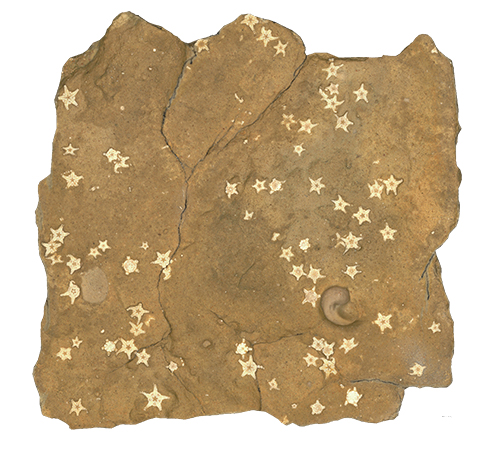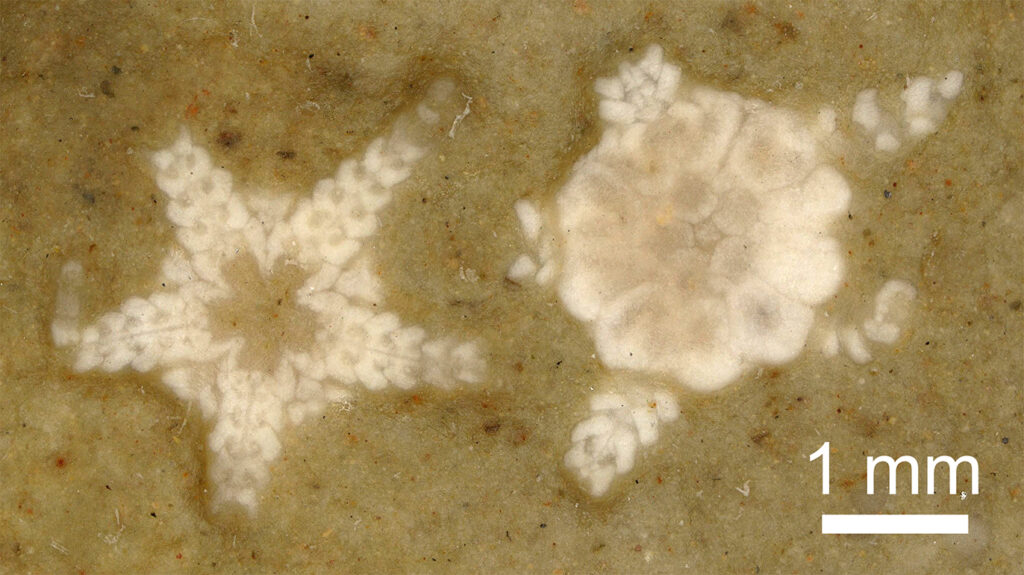December 2024: Brittle stars
Aspiduriella similis (Eck, 1865)
Middle Triassic (Muschelkalk, c. 240 million years)
Lower Gogolin beds, Wojkowice, Poland
Length of fossil-bearing rock: c. 8 cm

Brittle stars, scientifically known as Ophiuroidea, belong to the animal phylum Echinodermata. This phylum also includes sea urchins, starfish, sea cucumbers, sea lilies and feather stars. Typical for brittle stars are the long and slender arms, which are set off from the central body disk. The shape of the arms, but also their flexible movement, clearly refer to the naming of the animals. Brittle stars originated c. 480 million years ago in the Ordovician and have basically retained their body plan ever since. Their mode of life and morphology seem to have been so successful that their diversity and distribution were hardly negatively affected by mass extinction events.
Picture 1: Limestone piece with fossil brittle stars
(Aspiduriella similis).
The limestone piece exhibited here shows wonderfully preserved inner skeletons of brittle stars of the species Aspiduriella similis from Wojkowice quarry, which is located in the small village of Wojkowice in Upper Silesia (Poland). The piece comes from the Muschelkalk (Middle Triassic) and is therefore, approx. 240 million years old. During that time, the Germanic Basin consisted largely of an epicontinental sea, the so-called Muschelkalk Sea. This is why the genus Aspiduriella can also be found in other areas of the Germanic Basin, such as near Crailsheim in Baden-Württemberg.

The original habitat of Aspiduriella similis in Wojkowice was probably the shallow marginal area of the Muschelkalk Sea. It is possible that this area was even partially separated from the open sea. This is known because the Aspiduriella-bearing layers are characterised by evaporation of seawater. Consequently, the brittle stars had to be able to tolerate high salinity fluctuations in the water and basically a high salt content. This is surprising in that echinoderms are usually stenohaline, i.e. unable to tolerate high fluctuations in salinity.
Picture 2: Two specimens of Aspiduriella similis; left: ventral side (with mouth), right: dorsal side.
Aspiduriella similis was a brittle star species with comparatively short arms that lived on the sea floor. The tips of the arms are not preserved in the specimens from Wojkowice, which could be due to the fact that these skeletal elements are extremely small and could therefore easily drift away after the rapid decay and before embedding in sediment. In living Aspiduriella similis, the mouth side was always directed downwards to the substrate. However, most of the individuals on the limestone exhibited here are preserved with the mouth side facing upwards. A possible explanation for this would be that the surrounding environment became oxygen-depleted – a typical phenomenon in shallow, marginal marine areas (as in Wojkowice). Today’s brittle stars raise their body when there is lack of oxygen. In addition, stressed animals can be observed to spawn collectively, whereby they also have to raise themselves. It is possible that the fossil specimens from Wojkowice died during such processes and tipped over to the side facing away from the mouth.
Imelda M. Hausmann



